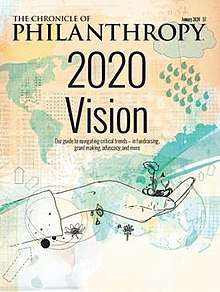The Chronicle of Philanthropy
The Chronicle of Philanthropy is a magazine that covers the nonprofit world of philanthropy. Based in Washington, DC, it is aimed at charity leaders, foundation executives, fund raisers, and other people involved in philanthropy. The Chronicle of Philanthropy publishes 12 issues a year while updating its Web site daily.[2] It was founded in 1988 by editor Phil Semas and then managing editor Stacy Palmer.[3] It is owned by The Chronicle of Higher Education Inc., which also publishes The Chronicle of Higher Education, a weekly newspaper covering colleges and universities.
 Cover of The Chronicle of Philanthropy (January 2020) | |
| Type | Monthly magazine |
|---|---|
| Owner(s) | The Chronicle of Higher Education Inc. |
| Editor | Stacy Palmer |
| Founded | 1988 |
| Language | English |
| Headquarters | 1255 Twenty-Third Street, N.W., Washington, D.C. 20037 |
| Circulation | 20,000+ (April 2019)[1] |
| ISSN | 1040-676X |
| Website | philanthropy |
Research projects
The Chronicle of Philanthropy is involved in research projects such as The Philanthropy 400, which annually ranks the nation's largest nonprofit groups based on the amount of money they raise,[4] and The Philanthropy 50, which ranks the individuals who give the most money to nonprofit groups each year.[5][6] According to a 2012 study by the Chronicle, the rich (those making over $100,000 a year) give a smaller share, averaging 4.2%, to charity than those poorer (between $50,000 - $75,000 a year), who give an average of 7.6%.[7][8] In 2007, they evaluated the credibility of celebrity in charitable giving and found that often celebrity involvement isn't as effective as the broader press attention it is given. [9]
Staff
The Chronicle of Philanthropy's editor is Stacy Palmer. Its managing editor is Dan Parks.[10]
See also
References
- "Advertising". Alliance for Audited Media. April 2019. Archived from the original on January 23, 2017. Retrieved June 18, 2013.
- "Archived copy". Archived from the original on 2013-11-26. Retrieved 2013-12-13.CS1 maint: archived copy as title (link)
- Cate Dody, "Who’s the Most Charitable of Us All? Celebrities Don’t Always Make the Cut", NY Times, September 10, 2007, https://www.nytimes.com/2007/09/10/business/media/10philanthropy.html
- "America's Top Fundraising Charities", Huffington Post, October 18, 2011, http://www.huffingtonpost.com/2011/10/18/charities-struggle-in-har_n_1015810.html
- Mike Boehm, "America's 50 top philanthropists include 12 arts donors", LA Times, February 6, 2012, http://latimesblogs.latimes.com/culturemonster/2012/02/chronicle-philanthropy-top-arts-donors.html
- Maria Di Mento and Caroline Preston, "College Benefactors Lead 'Philanthropy 50' Ranking of 2011's Top Donors", The Chronicle of Higher Education, February 6, 2012, http://chronicle.com/article/College-Benefactors-Lead/130680/
- Frank, Robert (August 20, 2012). "The Rich Are Less Charitable Than the Middle Class: Study". CNBC. Retrieved February 21, 2014.
- Kavoussi, Bonnie (August 21, 2012). "Rich People Give A Smaller Share Of Their Income To Charity Than Middle-Class Americans Do". The Huffington Post. Retrieved February 21, 2014.
- " Who's the Most Charitable of us all? Celebrities Don't Always Make the Cut", New York Times, Sept 10, 2007, https://www.nytimes.com/2007/09/10/business/media/10philanthropy.html
- "Archived copy". Archived from the original on 2014-05-19. Retrieved 2014-05-19.CS1 maint: archived copy as title (link)